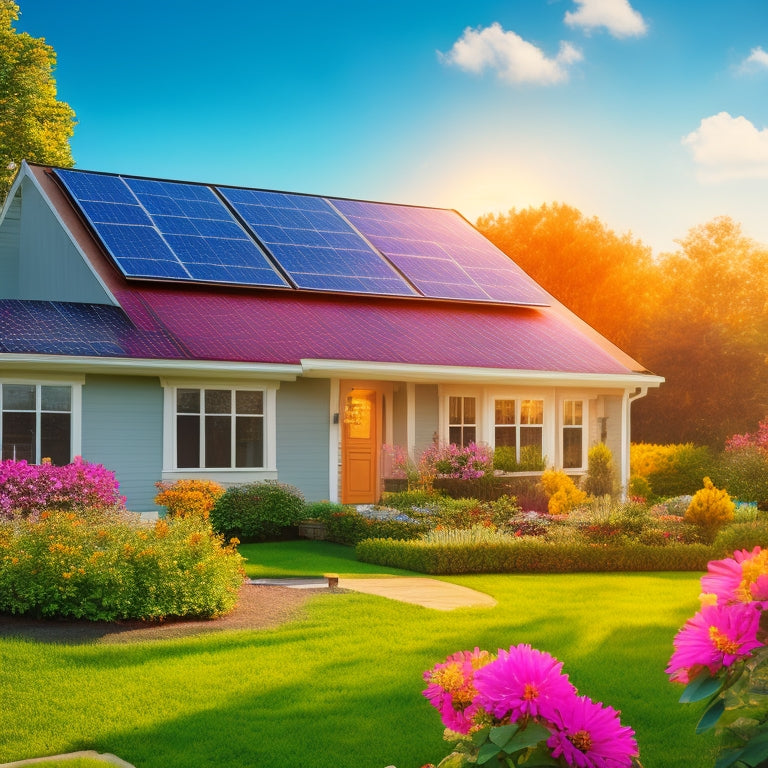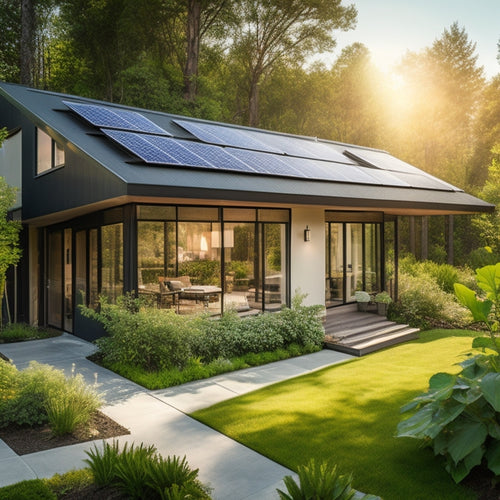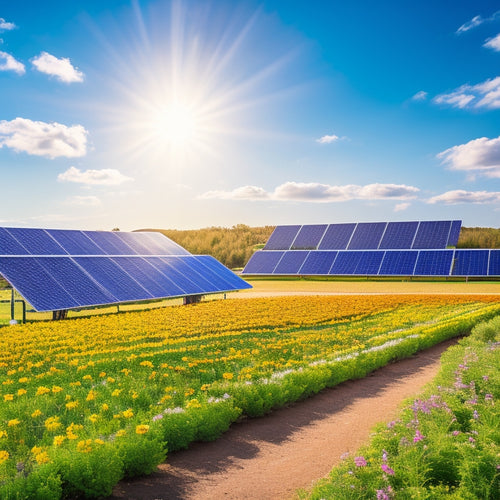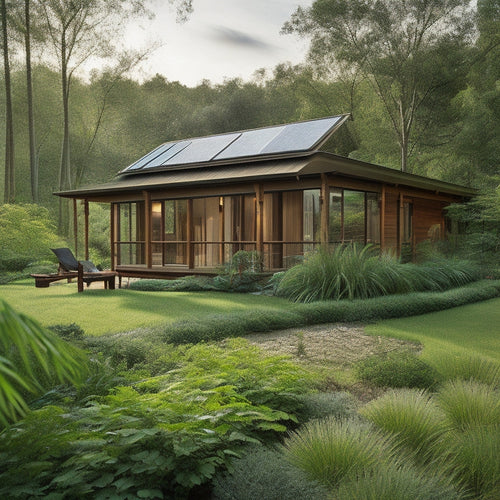
Top 7 Things to Know About Residential Solar Panel Price
Share
When considering residential solar panels, you'll want to understand the factors driving the cost. System size, location, and energy consumption needs greatly impact the overall price, which can range from $15,000 to $30,000 for a typical 5-kilowatt system. The average cost per watt is between $2.50 and $3.50, and national incentives like the Solar Investment Tax Credit can reduce upfront costs. Additionally, regional pricing environments, installation costs, and panel efficiency all play a role. By grasping these key factors, you'll be better equipped to make an informed investment decision - and there's more to investigate to guarantee you get the best deal for your money.
Key Takeaways
- Residential solar panel prices vary based on system size, location, energy consumption needs, and regional pricing landscape.
- The average cost per watt for residential solar panels ranges from $2.50 to $3.50, with total system costs between $15,000 and $25,000 for a typical 5-kilowatt system.
- National incentives like the Solar Investment Tax Credit (ITC) and state tax credits can significantly reduce upfront installation costs, making solar energy more affordable.
- Installation costs break down to include local permits, inspections, and maintenance expenses, which can range from $15,000 to $30,000 depending on the company and permits.
- High-quality solar panels with higher efficiency rates may cost more but can provide better energy output and longer system lifespan, typically up to 30 years or more.
Understanding Solar Panel Costs
When it comes to switching to renewable energy, understanding solar panel costs is essential to making an informed decision about residential solar panel installation.
You're likely reflecting on the financial benefits of going solar, including energy independence and long-term environmental benefits.
Solar financing options can help make the shift more affordable, but it's vital to factor in maintenance costs, which are typically low for solar panels.
You'll also need to take into account the cost of grid connection, which allows you to sell excess energy back to the utility company.
Fortunately, technology advancements have driven down the cost of solar panels over the years, making them a more viable option for homeowners.
Additionally, installation warranties provide peace of mind, ensuring your system operates at peak levels.
Factors Affecting System Prices
When you're evaluating residential solar panel prices, it's important to take into account the factors that impact the overall cost of your system.
You'll find that the size of your system is a significant factor, as larger systems require more equipment and labor, increasing the upfront cost.
Additionally, your location plays a vital role in determining the final price, as local permits, installation challenges, and regional labor rates vary widely.
System Size Matters
Determining the ideal system size is crucial in residential solar panel installations, as it greatly impacts the overall cost of the project. You'll want to verify your system can meet your energy consumption needs without overspending on unnecessary capacity.
| System Capacity | Energy Consumption | Installation Complexity |
|---|---|---|
| 3-5 kW | Low energy needs | Simple roof installation |
| 5-10 kW | Average energy needs | Standard roof installation |
| 10-15 kW | High energy needs | Complex roof installation |
| 15+ kW | Very high energy needs | Customized installation |
When selecting a system size, you'll need to evaluate factors such as panel types, financing options, and maintenance costs. A larger system may provide more power, but it also increases the upfront cost and may require a more complex installation. Additionally, you'll need to verify your system is compatible with your grid connection. By finding the right balance, you can optimize your energy production while keeping costs under control.
Location Impacts Cost
Across the United States, residential solar panel prices vary considerably depending on your location. You'll find that prices differ notably from one region to another due to various factors.
For instance, states with high solar market trends, such as California and Hawaii, tend to have lower prices due to economies of scale and fierce competition among installers. On the other hand, states with lower demand, like Mississippi and West Virginia, typically have higher prices.
Regional pricing also plays a crucial role in determining the cost of residential solar panels. You'll notice that prices are higher in urban areas and lower in rural areas. This is because urban areas often have higher labor and installation costs, while rural areas have lower costs due to lower labor rates and fewer installation companies.
As you consider installing solar panels, it's important to understand the regional pricing landscape in your area. By doing so, you'll be better equipped to negotiate with installers and get the best deal possible.
Average Cost per Watt
As you investigate the world of residential solar panels, one vital aspect to take into account is the average cost per watt. This metric provides a clear understanding of the expense involved in generating a unit of electricity. Currently, the average cost per watt for residential solar panels ranges from $2.50 to $3.50. This translates to a total system cost of $15,000 to $25,000 for a typical 5-kilowatt residential solar panel system.
When evaluating financing options, it's significant to reflect on the cost per watt. Leasing agreements, for instance, often quote prices regarding cost per watt. Be cautious, as seemingly low lease rates might hide higher costs per watt.
Understanding the average cost per watt enables you to make informed decisions about your investment. Additionally, it helps you compare different systems, financing options, and leasing agreements. By grasping this fundamental aspect, you'll be better equipped to maneuver through the intricate environment of residential solar panel pricing.
Installation Costs and Incentives
You'll need to take into account installation costs and incentives when calculating the total price of your residential solar panel system.
National incentives, such as the Solar Investment Tax Credit (ITC), can greatly reduce your upfront costs, and some states offer additional tax credits.
You'll want to factor in average installation costs, which vary depending on the system size, equipment, and labor costs in your area.
National Incentives Available
The federal government offers various incentives to encourage homeowners to invest in residential solar panels, driving down installation costs. As you consider investing in solar power, you can take advantage of these national incentives to reduce your upfront costs.
| Incentive | Type | Benefit |
|---|---|---|
| Federal Solar Investment Tax Credit (ITC) | Tax Credit | 26% of total system cost |
| Solar Renewable Energy Certificates (SRECs) | Certificate Program | Varies by state and market |
| Federal Rebates | Cash Rebate | $500-$2,000 |
| Solar Financing Options | Loan Programs | Low-interest rates, flexible terms |
| Net Metering | Utility Billing | Credits for excess energy generated |
These incentives can greatly reduce the cost of installing solar panels on your home. For example, the Federal Solar Investment Tax Credit (ITC) can provide a tax credit of 26% of the total system cost. Additionally, solar financing options offer low-interest rates and flexible terms to help you finance your solar panel installation. By taking advantage of these national incentives, you can make the switch to solar power more affordable.
State Tax Credits Offered
Beyond federal incentives, state tax credits can further reduce the cost of installing solar panels on your home. These state tax benefits vary depending on where you live, but they can be a significant factor in your decision to invest in solar energy.
To take advantage of these credits, you'll need to meet the eligibility requirements, which typically include owning a solar panel system, being a resident of the state, and meeting specific income considerations.
You'll need to go through an application process, which may involve filing paperwork and providing documentation to support your claim. Be sure to check the filing deadlines, as they can vary by state.
The tax credit limits also differ by state, so it's crucial to research the specific programs available in your area. By understanding these state-specific programs, you can maximize your solar investments and reduce your tax liability.
Average Installation Costs
Solar panel system installation costs vary widely depending on several factors, including system size, installation company, and local permits.
As you investigate your options, you'll find that the average installation cost for a residential solar panel system ranges from $15,000 to $30,000. However, this cost can be greatly reduced with financing options, such as loans or power purchase agreements, which can make solar more affordable.
When calculating the total installation cost, consider the system size, which is measured in watts. A typical residential system ranges from 3,000 to 10,000 watts.
The installation company you choose also impacts the cost, as reputable companies with experienced installers may charge more than smaller, less-experienced outfits. Additionally, local permits and inspections can add to the overall cost.
Remember to factor in ongoing maintenance expenses, which are relatively low for solar panels. With proper installation and maintenance, your system can last up to 30 years or more.
Panel Efficiency and Quality
About 20% of the total cost of your residential solar panel system goes into the panels themselves. This significant investment is essential, as high-quality panels directly impact your system's energy output and overall performance.
You'll encounter various panel types, each with unique characteristics, advantages, and price points. For instance, monocrystalline panels offer higher efficiency but come at a higher cost, while polycrystalline panels are more affordable but less efficient.
When selecting panels, consider warranty options, which typically range from 25 to 30 years. Look for manufacturers with a strong reputation, as they often provide better warranties and higher-quality products.
Performance degradation, or the rate at which panels lose efficiency over time, is another vital factor. High-quality panels typically degrade at a rate of 0.5% per year, ensuring consistent energy output.
Additionally, consider the installation materials used, as they can affect maintenance requirements. Reputable manufacturers provide durable panels with minimal maintenance needs.
System Size and Energy Needs
With your energy goals in mind, you'll need to establish the ideal system size for your residential solar panel installation. This involves evaluating your current energy consumption and power requirements to guarantee your system is optimized for maximum efficiency.
To do this, you'll need to conduct an efficiency analysis and load assessment to ascertain your residential needs. This will help you identify the size of the system required to meet your energy demands and achieve energy independence.
Some key factors to take into account when determining system size include:
- Your current energy consumption and usage patterns
- The amount of solar energy available at your location
- The efficiency of the solar panels and system components
- Any potential energy storage or backup requirements
Long-Term Savings and ROI
Having determined the ideal system size for your residential solar panel installation, you can now focus on the long-term financial benefits it will bring. With a well-designed system, you'll enjoy significant utility savings, reduced maintenance costs, and a substantial return on investment (ROI).
| Category | Benefit | Description |
|---|---|---|
| Financial Planning | Utility Savings | Reduce your electricity bills by up to 50% or more |
| Energy Independence | Reduced Reliance | Decrease your reliance on the grid and gain control over your energy costs |
| Environmental Impact | Carbon Footprint | Reduce your carbon footprint and contribute to a cleaner environment |
As you consider financing options, keep in mind that solar panels can increase your property value and provide a long-term ROI. With a typical system longevity of 25 years or more, you'll enjoy decades of energy independence and significant financial savings. By factoring in these benefits, you'll be able to make informed decisions about your residential solar panel installation and maximize your long-term returns.
Frequently Asked Questions
Can I Install Solar Panels on a Rental Property?
You can install solar panels on a rental property if you're the owner, but if you're a renter, you'll need to negotiate with your landlord, ensuring your rental agreements allow for solar panel ownership and installation.
Are Solar Panels Resistant to Hail and Extreme Weather?
You'll find solar panels are built to withstand extreme weather; they're designed with durability in mind, so you don't have to worry about hail or harsh conditions damaging your system, ensuring consistent energy production.
Do Solar Panels Work During Power Outages?
During power outages, you'll need a battery storage system to keep your solar panels running; without it, you won't have power. However, with a properly sized battery, your solar panel efficiency remains unaffected, providing you with reliable energy when you need it most.
Can I Add More Panels to My Existing System Later?
You can expand your existing solar panel system by adding more panels, but verify panel compatibility and consider installation costs, which may vary depending on your system's design and the number of panels you want to add.
Will Solar Panels Affect My Roof's Warranty?
Think you're stuck between a sunny disposition and a valid roof warranty? Fear not! You won't void your roof's warranty with solar panels, as long as you ascertain roofing material compatibility and review solar panel warranties that guarantee their work won't compromise your roof's integrity.
Conclusion
Now that you've got a better understanding of residential solar panel prices, it's time to take action. Remember, the cost of solar panels has dropped by 70% over the past decade, making it a more accessible option than ever. In fact, did you know that the average American family can save around $500 per year on their electricity bill by switching to solar? With solar panel prices decreasing and energy savings increasing, it's an investment worth considering.
Related Posts
-

Integrating Solar Panels Into Home Design
Integrating solar panels into your home design greatly enhances energy efficiency and lowers utility bills while addi...
-

High-Performance Solar Solutions for Sustainable Living
High-performance solar solutions are your gateway to sustainable living, maximizing energy efficiency while considera...
-

Affordable Sustainable Building Materials for Homes
You can build an eco-friendly home on a budget by choosing affordable sustainable materials. Consider using reclaimed...


